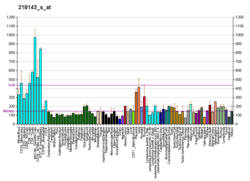Secretory carrier-associated membrane protein 2 is a protein that in humans is encoded by the SCAMP2 gene.[5][6]
This gene product belongs to the SCAMP family of proteins which are secretory carrier membrane proteins. They function as carriers to the cell surface in post-golgi recycling pathways. Different family members are highly related products of distinct genes, and are usually expressed together. These findings suggest that the SCAMPs may function at the same site during vesicular transport rather than in separate pathways.[6]
Further reading
- Wu TT, Castle JD (1997). "Evidence for colocalization and interaction between 37 and 39 kDa isoforms of secretory carrier membrane proteins (SCAMPs)". J. Cell Sci. 110 (13): 1533–41. PMID 9224770.
- Guo Z, Liu L, Cafiso D, Castle D (2002). "Perturbation of a very late step of regulated exocytosis by a secretory carrier membrane protein (SCAMP2)-derived peptide". J. Biol. Chem. 277 (38): 35357–63. doi:10.1074/jbc.M202259200. PMID 12124380.
- Liu L, Guo Z, Tieu Q, et al. (2003). "Role of Secretory Carrier Membrane Protein SCAMP2 in Granule Exocytosis". Mol. Biol. Cell. 13 (12): 4266–78. doi:10.1091/mbc.E02-03-0136. PMC 138632. PMID 12475951.
- Strausberg RL, Feingold EA, Grouse LH, et al. (2003). "Generation and initial analysis of more than 15,000 full-length human and mouse cDNA sequences". Proc. Natl. Acad. Sci. U.S.A. 99 (26): 16899–903. doi:10.1073/pnas.242603899. PMC 139241. PMID 12477932.
- Ota T, Suzuki Y, Nishikawa T, et al. (2004). "Complete sequencing and characterization of 21,243 full-length human cDNAs". Nat. Genet. 36 (1): 40–5. doi:10.1038/ng1285. PMID 14702039.
- Gerhard DS, Wagner L, Feingold EA, et al. (2004). "The Status, Quality, and Expansion of the NIH Full-Length cDNA Project: The Mammalian Gene Collection (MGC)". Genome Res. 14 (10B): 2121–7. doi:10.1101/gr.2596504. PMC 528928. PMID 15489334.
- Lin PJ, Williams WP, Luu Y, et al. (2005). "Secretory carrier membrane proteins interact and regulate trafficking of the organellar (Na+,K+)/H+ exchanger NHE7". J. Cell Sci. 118 (Pt 9): 1885–97. doi:10.1242/jcs.02315. PMID 15840657.
- Stelzl U, Worm U, Lalowski M, et al. (2005). "A human protein-protein interaction network: a resource for annotating the proteome". Cell. 122 (6): 957–68. doi:10.1016/j.cell.2005.08.029. PMID 16169070.
- Rual JF, Venkatesan K, Hao T, et al. (2005). "Towards a proteome-scale map of the human protein-protein interaction network". Nature. 437 (7062): 1173–8. doi:10.1038/nature04209. PMID 16189514.
- Müller HK, Wiborg O, Haase J (2006). "Subcellular redistribution of the serotonin transporter by secretory carrier membrane protein 2". J. Biol. Chem. 281 (39): 28901–9. doi:10.1074/jbc.M602848200. PMID 16870614.
- Liao H, Ellena J, Liu L, et al. (2007). "Secretory carrier membrane protein SCAMP2 and phosphatidylinositol 4,5-bisphosphate interactions in the regulation of dense core vesicle exocytosis". Biochemistry. 46 (38): 10909–20. doi:10.1021/bi701121j. PMID 17713930.




